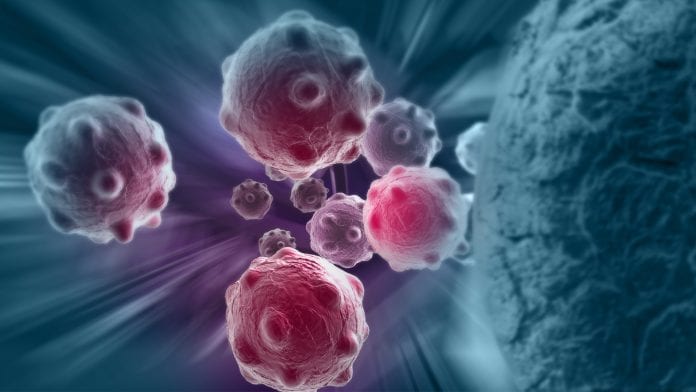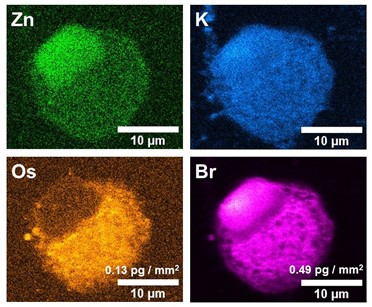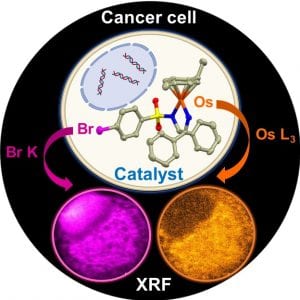
In a major step forward in discovering cancer treatments, scientists at the University of Warwick have tracked how the rare precious metal Osmium reacts in a single cancer cell.
Osmium could potentially be used to treat cancer with fewer side effects than Platinum, which is currently used in almost half of all anti-cancer drugs used in chemotherapies.
Once inside the cancer cell, platinum reacts with the nucleus, sometimes leading to negative side effects of the treatment. Therefore, research into Osmium as a potential alternative to platinum is a big step forward in the discovery of anti-cancer drugs with fewer side effects.

Credit: University of Warwick
In a paper published in the journal Angewandte Chemie, researchers at the University of Warwick outline how they used a 185-metre synchrotron beamline at the Diamond synchrotron to track the reaction of Osmium in single human lung cancer cell, at a scale of 100 nanometres.
The researchers found that Osmium reacts and stays in the cytoplasm of the cancer cell, rather than the nucleus, which could reduce side effects if used in cancer treatment.
Professor Peter Sadler, from the Department of Chemistry at the University of Warwick said: “With one in two people getting cancer in their lifetime, the need to find new drugs has never been more urgent. Part of drug discovery is seeing exactly how they react and work in cells.
“Osmium is a rare precious metal, however, since it can act as a catalyst, a very little amount is needed for reactions in the cancer cell, therefore it could be a sustainable treatment going forward. We wanted to see how exactly it worked in a single cancer cell, which involved a variety of novel techniques, including taking water molecules out of the cell and rapidly flash-freezing it. Whereas usually cells are chemically altered to see the reactions, in our method they are close to their natural state, making our results more authentic.”

Credit: University of Warwick
Dr Elizabeth Bolitho, of Diamond and the Department of Chemistry commented: “We worked 24- hours-a-day, five-days-a-week to collect these exciting data, allowing us to see inside cancer cells to a nanoscale resolution. This has provided crucial insights into potential cellular targets of such Osmium catalysts.
“Not only were we able to track the Osmium in a lung cancer cell, but more widely in breast cancer, ovarian and prostate cancer cells, for example, which provides hope that in the future Osmium could be used to treat a range of different cancers.”
Professor Sadler said: “Our team hopes to progress their discoveries through pre-clinical development towards new Osmium drugs for cancer treatment, although this typically takes several years. If we succeed, then the days and sleepless nights spent collecting XRF data at the Diamond synchrotron will certainly have been worthwhile.”
Diamond Light Source imaging group leader, Paul Quinn, added: “The collaboration between Warwick and the I14 beamline is very exciting. Our research has exploited the advanced nano-imaging methods we’ve developed and built at Diamond to neatly image the location of these drugs within cancer cells and gain significant insights into how they interact.”









